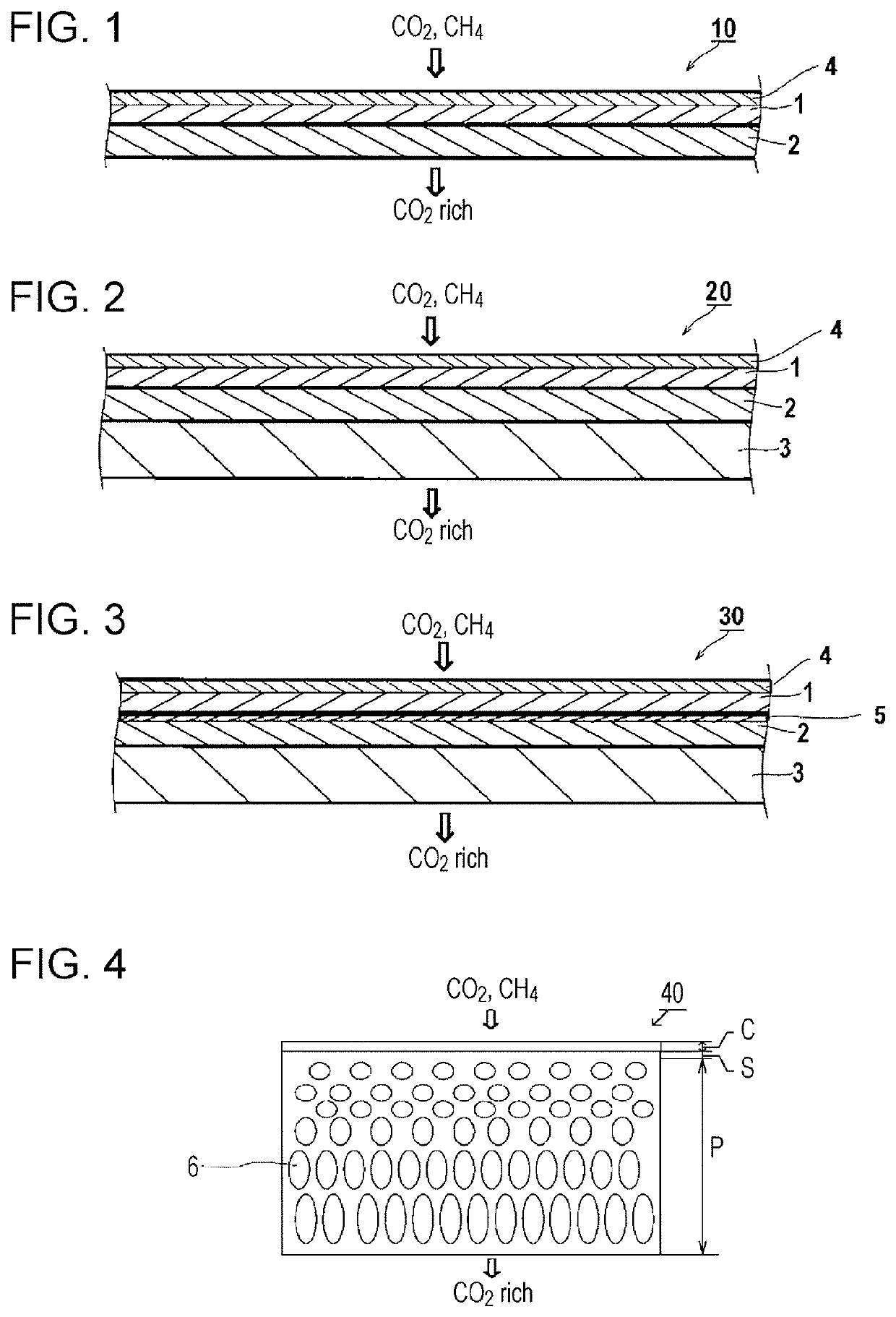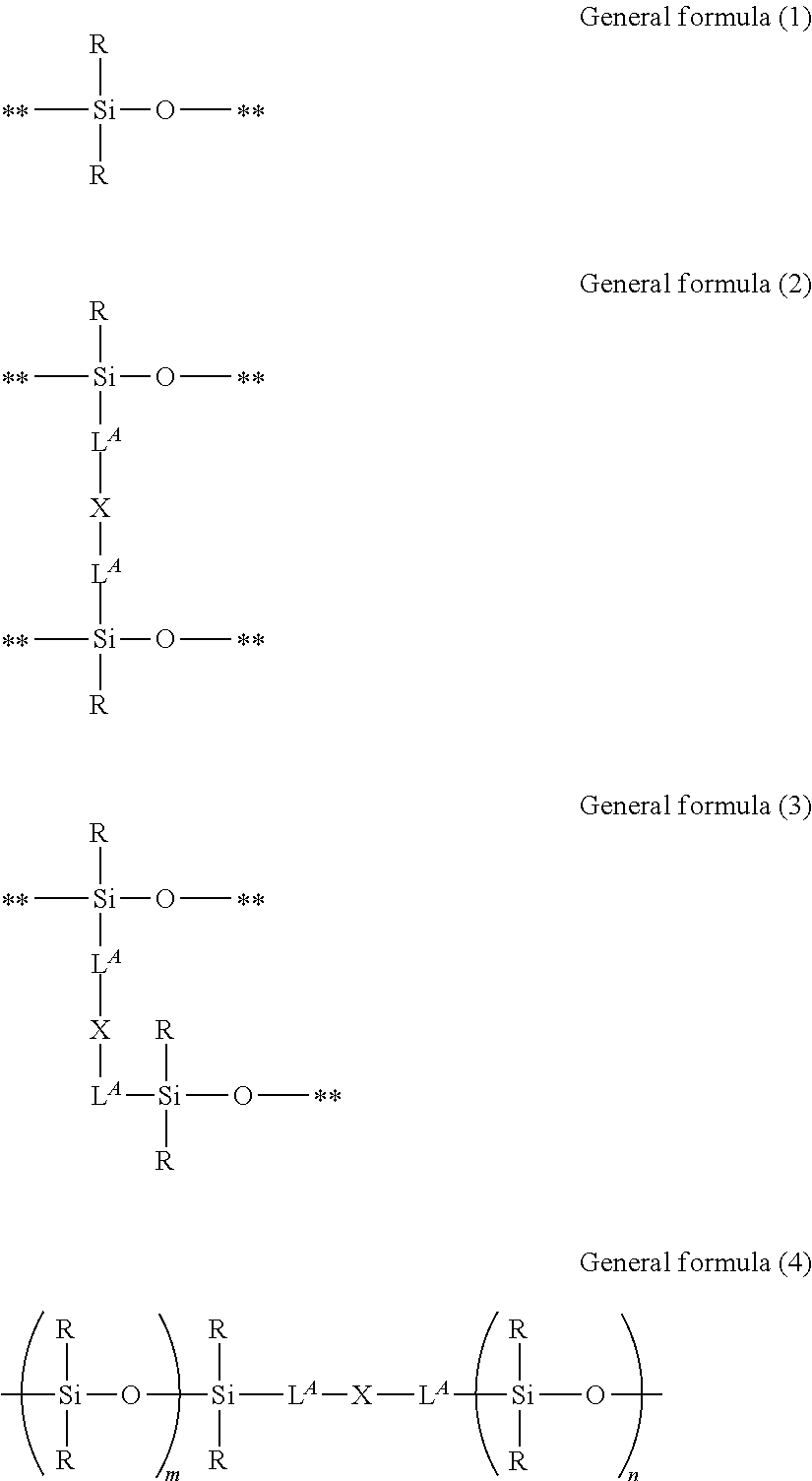Gas separation membrane, gas separation module, gas separation apparatus, and gas separation method
a gas separation membrane and gas separation technology, applied in the field of gas separation membranes, gas separation modules, gas separation apparatuses, etc., can solve the problems of difficult to prevent plasticization of membranes, and achieve good gas separation performance, good gas separation selectivity, and good gas permeability
- Summary
- Abstract
- Description
- Claims
- Application Information
AI Technical Summary
Benefits of technology
Problems solved by technology
Method used
Image
Examples
example 1
[Example 1] Preparation of Asymmetric Membrane
[0209]To 0.5 g of cellulose acetate (trade name: L-70, available from Daicel Corporation, acetylation degree 0.55, where the term “acetylation degree” refers to a weight percentage of bonded acetic acid per unit weight) serving as a cellulose resin, a mixture of 2.5 g of methyl ethyl ketone, 2.5 g of N,N-dimethylformamide (DMF), and 0.6 g of n-butanol was added to dissolve the cellulose acetate. The resulting solution was filtered with a PTFE microfiltration membrane having a pore size of 5.0 μm to prepare a dope solution.
[0210]A polyester nonwoven fabric (available from Awa Paper Mfg. Co., Ltd., thickness: 95 μm) was placed on a clean glass plate (10 cm in length×10 cm in width×1 mm in thickness, hereinafter the same), and the dope solution was applied onto the nonwoven fabric at room temperature (20° C.). The resulting glass plate was allowed to stand for 30 seconds and then immersed in a primary coagulating liquid (0° C., 75% by mass ...
examples 2 to 24
[Examples 2 to 24] Preparation of Asymmetric Membranes
[0214]Asymmetric membranes (gas separation membranes) of Examples 2 to 24 were prepared as in Example 1 except that cellulose resins and siloxane compounds described in Tables 1-1 to 1-4 were used instead of the cellulose resin (cellulose acetate) and the siloxane compounds (Compound 1 and Compound 2) used in Example 1, and crosslinking agents (metal complexes) described in Tables 1-1 to 1-4 were added to radiation-curable compositions used in the formation of siloxane compound layers.
[0215]Instead of the N,N-dimethylformamide used as a medium of the dope solution for forming an asymmetric membrane in Example 1, N-methyl-2-pyrrolidone was used in Examples 4 to 14 and Example 16, dimethyl sulfoxide was used in Examples 15 and 20, N-ethyl-2-pyrrolidone was used in Example 18, γ-butyrolactone was used in Example 19, dimethylacetamide was used in Example 21, methylene chloride was used in Example 22, dioxane was used in Example 23, a...
example 25
[Example 25] Preparation of Composite Membrane
Preparation of PAN Porous Membrane with Smooth Layer
Preparation of Radiation-Curable Polymer Having Dimethylsiloxane Structure
[0260]A both-terminal methacrylate-modified polydimethylsiloxane X-22-164E (Compound 1, available from Shin-Etsu Chemical Co., Ltd.) (39 g) and a both-terminal thiol-modified polydimethylsiloxane X-22-167B (Compound 2, available from Shin-Etsu Chemical Co., Ltd.) (10 g) were placed in a 300 mL three-necked flask, and 50 g of n-heptane was further added to the flask to dissolve the polydimethylsiloxanes. The resulting solution was maintained at 50° C. for five hours to prepare a solution of a radiation-curable polymer having a polysiloxane structure.
Preparation of Radiation-Curable Composition
[0261]The radiation-curable polymer solution (5 g) was cooled to 20° C. and diluted by adding 95 g of n-heptane. Irgacure 184 (available from BASF) (0.01 g) as a photopolymerization initiator was added to the resulting solutio...
PUM
| Property | Measurement | Unit |
|---|---|---|
| thickness | aaaaa | aaaaa |
| thickness | aaaaa | aaaaa |
| thickness | aaaaa | aaaaa |
Abstract
Description
Claims
Application Information
 Login to View More
Login to View More - R&D
- Intellectual Property
- Life Sciences
- Materials
- Tech Scout
- Unparalleled Data Quality
- Higher Quality Content
- 60% Fewer Hallucinations
Browse by: Latest US Patents, China's latest patents, Technical Efficacy Thesaurus, Application Domain, Technology Topic, Popular Technical Reports.
© 2025 PatSnap. All rights reserved.Legal|Privacy policy|Modern Slavery Act Transparency Statement|Sitemap|About US| Contact US: help@patsnap.com



